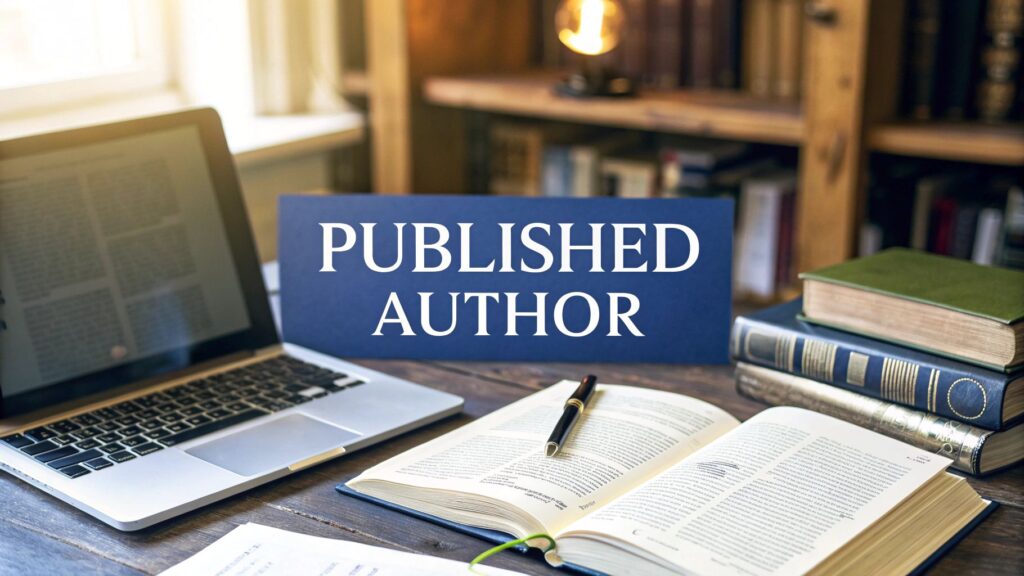Choosing Your Publishing Path: Traditional Vs. Self-Publishing
The journey to becoming a published author offers two primary routes: traditional publishing and self-publishing. Each presents unique advantages and challenges. The best path depends on individual goals and resources. This infographic visualizes the decision-making process, outlining the available paths for both fiction and non-fiction writers:

As the infographic shows, both traditional and self-publishing are viable options, regardless of genre. Understanding the nuances of each is crucial for making an informed decision. Learning about the publishing process is essential for any aspiring author. Check out this helpful article on How To Publish a Novel. Now, let's explore each path in detail.
Traditional Publishing: The Established Route
Traditional publishing involves partnering with a publishing house. The publisher manages editing, printing, distribution, and marketing. Authors often receive an advance payment against future royalties. For instance, an author might receive a $5,000 advance, earned back as their book sells. Traditional publishing also offers the perceived prestige of being selected by a recognized publishing house.
However, the process can be long and competitive. Between 600,000 and 1 million books are traditionally published annually. Yet, traditional publishers accept only about 2% of submitted manuscripts. This low acceptance rate demonstrates the competitive landscape. Persistence and high-quality writing are key. More detailed publishing statistics are available here. Traditional publishing also means ceding some creative control to the publisher.
Self-Publishing: The Independent Approach
Self-publishing gives authors complete control. They manage every aspect, from editing and cover design to formatting, distribution, and marketing. Self-publishing offers faster publishing timelines and higher royalty percentages than traditional publishing. This resource offers valuable insights into self-publishing: How to Master Publishing.
However, self-published authors cover all upfront costs, including editing, cover design, and marketing. This can be a substantial investment, especially for new authors. Self-published authors also handle all marketing, which can be time-consuming.
To understand the key differences between these two publishing paths, refer to the comparison table below:
Traditional vs Self-Publishing Comparison
A comprehensive comparison of traditional and self-publishing models covering costs, timelines, control, and earnings potential
| Aspect | Traditional Publishing | Self-Publishing |
|---|---|---|
| Costs | Publisher covers all costs | Author covers all costs |
| Timelines | Longer process (months to years) | Faster process (weeks to months) |
| Control | Less creative control | Complete creative control |
| Earnings Potential | Lower royalty percentage, but potential for advance | Higher royalty percentage, but no advance |
| Marketing | Publisher handles marketing | Author handles marketing |
| Distribution | Wider distribution through publisher's network | Author responsible for distribution |
This table highlights the trade-offs between traditional and self-publishing. Traditional publishing offers support and wider distribution, but less control and lower royalties. Self-publishing provides complete control and higher royalties, but requires more upfront investment and effort.
Making the Right Choice for You
The ideal publishing path depends on your individual needs and priorities. Do you value creative control, a fast publishing process, and potentially higher royalties? Then self-publishing might be the right fit. Do you prefer the guidance and resources of a publisher and a longer timeline? Then traditional publishing could be the better option. There's no single "right" answer. Both paths can lead to a successful writing career.
Crafting Manuscripts That Stand Out From The Crowd
A well-written manuscript is the foundation of a successful publishing journey. However, in today's competitive market, quality writing alone isn't enough. Your manuscript must captivate agents and editors from the very first page. This requires understanding their expectations and avoiding common pitfalls that often lead to rejection.
Understanding the Market and Genre
Before you begin writing, research your target market. Understanding reader preferences, current trends, and the competitive landscape is crucial for creating a marketable manuscript. For instance, if you're writing fantasy, explore popular subgenres and tropes to see what resonates with readers. This isn't about copying existing work; it's about finding opportunities to offer a fresh perspective within the genre.
Familiarize yourself with genre conventions while still striving for originality. Every genre has established norms and reader expectations. Knowing these allows you to play with them, subvert them, or adhere to them in innovative ways. This balance between the familiar and the fresh can be key to capturing the attention of publishing professionals.
Compelling Opening Pages and a Strong Narrative Structure
Your opening pages are your first impression. A compelling opening must immediately grab the reader's attention, establish a clear voice, and introduce the central conflict or question driving the narrative. Think of it as a movie trailer – it needs to be enticing.
A strong narrative structure is equally important for maintaining reader engagement. This involves careful pacing, well-developed characters, and a plot that builds tension and delivers satisfying resolutions. Your narrative structure is the blueprint of your story, and a solid blueprint is essential.
Self-Editing for Professional Standards
Before submitting your manuscript, thorough self-editing is essential. This goes beyond checking for grammar and spelling. It involves critically evaluating your work for clarity, consistency, and impact. Resources like those offered by BarkerBooks on Mastering Self-Publishing can be invaluable.
-
Clarity: Ensure your writing is concise and easy to understand. Avoid complex sentences or jargon that could confuse your reader.
-
Consistency: Pay close attention to character development, plot points, and world-building. Ensure all elements of your story remain consistent from beginning to end.
-
Impact: Consider the emotional impact of your writing. Are you effectively conveying the intended emotions to your audience?
Self-editing can be challenging, but it's essential for presenting a polished manuscript. This dedication to quality demonstrates to agents and editors that you take your work seriously. Crafting a standout manuscript combines compelling storytelling, market awareness, and a commitment to professional standards. By focusing on these elements, you significantly improve your chances of achieving your publishing goals.
Navigating Traditional Publishing Like A Pro

Traditional publishing can feel overwhelming. However, a strategic approach can significantly improve your odds of success. This involves understanding each step, from securing a literary agent to managing revisions. It's a journey that demands both perseverance and professionalism.
Researching Literary Agents
Finding the right literary agent is essential to becoming a published author. Begin by researching agents specializing in your genre. Look for those with a demonstrated history of success and who are actively seeking new clients. Resources like Agent Query are invaluable for identifying potential agents. Attending writers' conferences can also provide networking opportunities and insights into agents' interests.
Crafting a Compelling Query Letter
Your query letter is your first introduction. It's a concise and captivating presentation of your manuscript. It should showcase the unique elements of your story and highlight its market potential. Be sure to include a brief synopsis, your target audience, and any relevant writing credentials. A well-crafted query letter can be the deciding factor in whether an agent requests your manuscript or sends a rejection.
Understanding the Submission Timeline
Traditional publishing is a time-intensive process. Be prepared for a considerable waiting period between submitting your query and receiving a response. This can take anywhere from several weeks to several months. Securing an agent is only one step. The subsequent search for a publisher can also be lengthy. Patience and persistence are vital. Managing your expectations and focusing on other writing projects during this waiting period can be beneficial.
Handling Rejection Professionally
Rejection is an inherent aspect of the publishing journey. Even accomplished authors encounter rejection throughout their careers. Handling rejection gracefully is crucial. Consider it a learning opportunity. If an agent offers feedback, use it to revise your query or manuscript. Don't be discouraged by setbacks. Keep honing your craft and submitting your work. This process cultivates resilience. Remember, rejection from one agent or publisher doesn't diminish your book's value. It simply indicates it wasn't the right fit at that specific moment. Continuous improvement and consistent submission efforts will ultimately lead you to the right opportunity.
Mastering Self-Publishing As A Business Strategy
Self-publishing has evolved from a last resort for authors into a viable business model. Thousands of authors are now finding success through independent publishing. This section explores the entire self-publishing process, from manuscript preparation to reaching a global audience.
Essential Investments for Self-Published Authors
Some investments are essential for producing a professional-quality book. Professional editing is crucial. A good editor polishes your writing, identifies plot issues, and ensures your manuscript is error-free. Cover design is equally vital. A book cover is the first impression for potential readers; it must be both eye-catching and professional.
Finally, formatting is key for a positive reading experience. A well-formatted book improves readability and projects professionalism. Investing in these services can significantly improve your chances of success.
Leveraging Self-Publishing Platforms
Several platforms help authors self-publish effectively. Amazon Kindle Direct Publishing (KDP) is a major player, offering access to a large audience. Amazon KDP provides tools and resources for formatting, publishing, and promoting your book. IngramSpark offers broader distribution, reaching bookstores and libraries. IngramSpark is known for its print-on-demand services and wider reach within the traditional publishing ecosystem.
Draft2Digital simplifies distribution to multiple platforms, including Apple Books and Barnes & Noble. Draft2Digital is a valuable tool for reaching a wider audience across various ebook retailers. Choosing the right platform for your audience is important.
Metadata Optimization and Category Selection
Metadata, including your title, subtitle, description, and keywords, is critical for book discoverability. Optimize your metadata with relevant keywords readers might use when searching for books in your genre.
Selecting the correct categories for your book is equally important. Accurate categorization helps your book reach the right readers browsing online bookstores.
Self-publishing continues to grow. Self-published titles with ISBNs saw a 7.2% increase in 2023, totaling over 2.6 million books. This growth demonstrates the increasing popularity and viability of self-publishing as a career path. Find more detailed statistics here. You may also be interested in How to Master Ghostwriting.
Case Studies and Business Skills for Long-Term Success
Studying successful self-published authors can provide valuable insights. By examining their strategies, you can learn how they built their audience and marketed their books to achieve consistent sales.
Self-publishing is a business. Understanding marketing, advertising, and financial management is critical for long-term success. Self-publishing requires time. Balancing writing with marketing and administrative tasks requires planning and effective time management.
Building Your Author Platform Before You Need It

Savvy authors know that publishing a book is just one piece of the puzzle. Building an author platform is essential for connecting with readers and achieving your publishing aspirations. This isn't about relentless self-promotion, but about forming authentic relationships with your audience. Begin this process during your writing phase, not after publication.
The Power of Social Media and Email Lists
Social media provides potent tools for engaging directly with readers. Each genre, however, has its own best practices. Visual platforms like Instagram might be perfect for showcasing illustrated children's books, while Twitter could be better for connecting with non-fiction readers. Identify the platforms your target audience frequents and tailor your content accordingly.
Building an email list is crucial. It offers a direct communication channel with readers interested in your work. Provide valuable content, like previews of your writing or insights into your creative process, in exchange for email sign-ups. This allows you to announce book releases, share updates, and nurture lasting reader relationships.
Creating a Professional Author Website
Your website is your online home. It should showcase your work professionally and offer essential information about you and your books. Key elements include:
- Author Bio: A concise and engaging biography that introduces you and your writing to readers.
- Book Information: Individual pages for each book, including synopses, reviews, and purchase links.
- Contact Information: Easy access for readers and media to get in touch with you.
- Blog: A space to share thoughts, insights, and updates on your writing journey.
A well-designed website builds credibility and gives readers a central location to learn more about you and your work. Learn more in our article about How to Master Author Training.
Networking Within Your Genre and Building Authority
Connecting with other authors in your genre is invaluable. It fosters mutual support, collaboration, and shared learning. Attend writers' conferences, join online writing communities, and engage with other authors on social media.
Establish yourself as a trusted voice in your field. This requires consistently creating valuable, genre-related content. Share your expertise, offer helpful advice, and participate in relevant online discussions. Building authority takes time, but positions you as a go-to resource for readers interested in your genre.
Balancing Writing Time With Platform Building and Measuring Effectiveness
Balancing writing with platform building is challenging for all authors. Develop a realistic schedule that allocates time for both. This might involve setting daily or weekly goals for writing and platform building activities.
Measuring the effectiveness of your platform-building efforts is key. Track website traffic, social media engagement, and email list growth. This data reveals what’s working and what needs adjustment. Regularly evaluating your efforts allows you to refine your strategies and ensure your time is used effectively. Avoid spending hours on platforms that don't connect you with actual readers. Focus on building authentic relationships and creating valuable content that resonates with your target audience. This forms the foundation of a successful and sustainable writing career.
Marketing Your Book Like Industry Veterans Do

Marketing is essential for all published authors, regardless of whether they've chosen traditional or self-publishing. Successful book marketing goes beyond simple social media posts; it demands a strategic approach to generate sales and build a dedicated readership. This section explores budget-friendly tactics and premium marketing strategies for effective book promotion.
Effective Launch Strategies
A well-planned launch is vital for creating initial buzz and driving early sales. This involves building anticipation before the release date.
Strategies include pre-orders, cover reveals, and engaging with your audience on platforms like Facebook and Instagram. For example, offer exclusive content or early bird discounts to those who pre-order.
Consider hosting a virtual or physical launch event. This allows you to celebrate your publication and connect directly with readers. Building a successful author platform involves creating engaging content; you can learn more about a strong LinkedIn content strategy. A strong platform enables you to reach a wider audience and establish yourself as a thought leader.
Review Acquisition and Book Promotion Sites
Reviews are critical for book discoverability and sales. Encourage early readers to leave honest reviews on platforms like Amazon and Goodreads. These reviews build social proof and influence potential buyers.
However, it's important to adhere to platform guidelines for review acquisition. Don't purchase reviews or engage in unethical practices. Focus on building genuine reader relationships and encouraging organic feedback.
Many book promotion sites can boost visibility. Research these platforms carefully to identify the best fit for your genre and target audience. Some sites specialize in specific genres, while others have a broader reach. Invest wisely in promotion and track your results to see what works.
Optimizing Discoverability and Running Cost-Effective Ads
Optimizing your book's metadata is crucial for being found by potential readers. Use relevant keywords in your title, subtitle, and description to improve search results on online bookstores. Choose appropriate categories to help readers discover your book while browsing.
Cost-effective advertising campaigns can significantly expand your audience. Platforms like Amazon Ads and Facebook Ads allow targeted advertising. Focus your ads on specific demographics and interests, reaching potential readers most likely to buy your book. Start small and track results to optimize your campaigns over time.
Leveraging Word-of-Mouth and Building Sustainable Sales Momentum
Word-of-mouth marketing remains a powerful tool. Encourage readers to share your book with their networks. This organic growth can reach more people than paid advertising alone. Offer incentives for sharing, such as exclusive content or early access to your future work.
Long-term success hinges on building sustainable sales momentum. Focus on activities that continue to generate sales long after your initial launch. Effective strategies include:
- Regular content creation: Engage with your audience consistently.
- Consistent social media presence: Maintain visibility and connect with readers.
- Ongoing engagement with readers: Build a loyal fan base and foster strong relationships.
By implementing these strategies, you can build a sustainable writing career. This fosters both long-term growth and reader loyalty. Analyzing successful book marketing campaigns can offer valuable insights. Study tactics other authors have employed, then adapt and apply these strategies to your own marketing efforts.
Staying Ahead: Industry Trends And Future Opportunities
The publishing industry is constantly changing, presenting both obstacles and exciting new avenues for authors. Understanding these emerging trends is essential for navigating this evolving market and achieving long-term success. This requires authors to adapt their strategies, embrace new technologies, and remain focused on the power of compelling storytelling.
Emerging Trends Reshaping The Publishing Landscape
Several key trends are transforming how readers discover, acquire, and engage with books:
-
The Rise of Audiobooks and Ebooks: Digital formats continue to grow in popularity, offering convenience and accessibility to a wider audience. Authors should consider formatting options from the outset of their writing process.
-
Personalized Reading Experiences: Readers are increasingly seeking tailored content recommendations and interactive reading experiences. Authors can capitalize on this by directly engaging with their readers and fostering strong online communities.
-
The Importance of Author Platforms: A robust author platform—including a website, social media presence, and email list—is now vital for connecting with readers and effectively promoting books. This direct connection cultivates reader loyalty and boosts sales.
-
The Growing Influence of Social Media Marketing: Social media plays a major role in book discovery. Authors who effectively leverage these platforms can connect with new readers and generate excitement for their work.
To illustrate how authors can adapt and capitalize on these shifts, let’s examine some specific trends and actionable strategies:
| Trend | Impact on Authors | Action Steps |
|---|---|---|
| Rise of Audiobooks & Ebooks | Expanded reach, accessibility | Produce books in multiple formats (audio, ebook, print) |
| Personalized Reading Experiences | Increased reader engagement | Build online communities, interact directly with readers |
| Importance of Author Platforms | Direct reader connection, marketing control | Develop a professional website, cultivate an email list, build a social media presence |
| Social Media Marketing | Enhanced discoverability | Implement a targeted social media strategy, engage with readers online |
This table, "Publishing Industry Trends and Author Opportunities," summarizes key trends impacting the publishing industry and offers practical steps for authors to leverage these changes. By adapting to these evolving dynamics, authors can position themselves for greater success.
Adapting Strategies For Long-Term Success
Successful authors are embracing these changes by:
-
Embracing Diverse Formats: Offering books in various formats like ebook, print, and audiobook caters to a wider audience and maximizes reach.
-
Building Strong Online Communities: Engaging with readers on platforms like Facebook and Instagram, hosting online events, and building email lists creates a devoted following.
-
Investing in Professional Services: Professional editing, cover design, and marketing support remain crucial for presenting a polished product and reaching a larger audience.
These strategies demonstrate the importance of adaptability and a proactive approach to book marketing in the current publishing landscape. As publishing evolves, staying informed about industry shifts is crucial. For instance, building loyal audiences, using email marketing services effectively, and experimenting with pricing models are becoming increasingly important. The lines between traditional and independent publishing are also blurring. The rise of AI tools offers authors new possibilities for creative expression. Explore this topic further here.
Future Opportunities For Published Authors
The future of publishing holds immense potential. Emerging technologies, like AI-powered writing tools and virtual reality experiences, could reshape storytelling and reader engagement. Authors who embrace these advancements will be well-positioned to connect with readers in innovative ways. However, it’s essential to remember that technology should enhance storytelling, not dictate it. Focusing on compelling narratives and genuine reader connections will always be fundamental to successful authorship.
Ready to begin your publishing journey with expert guidance and support? Transform your manuscript into a professionally published book with BarkerBooks. Visit BarkerBooks today and learn how we can help you achieve your publishing aspirations.
Article created using Outrank
